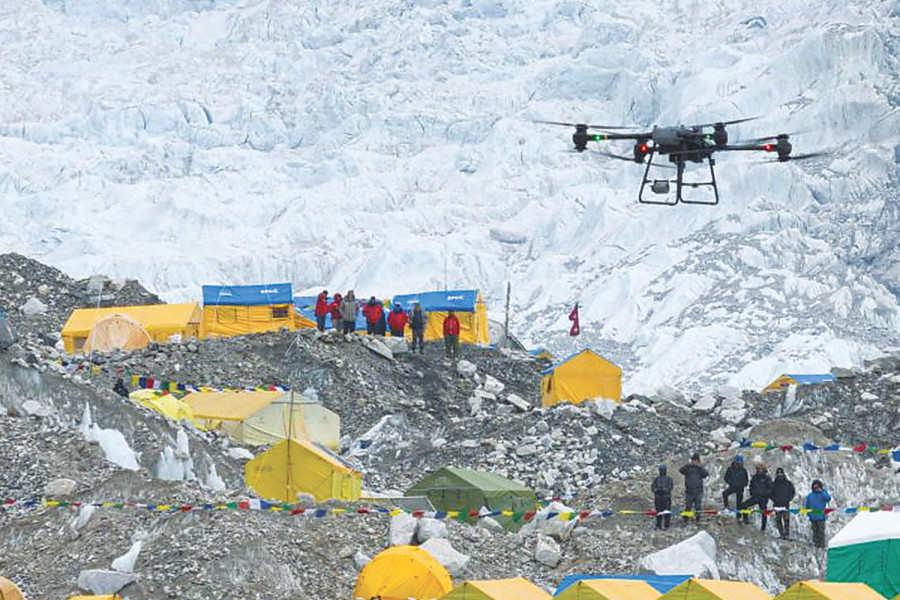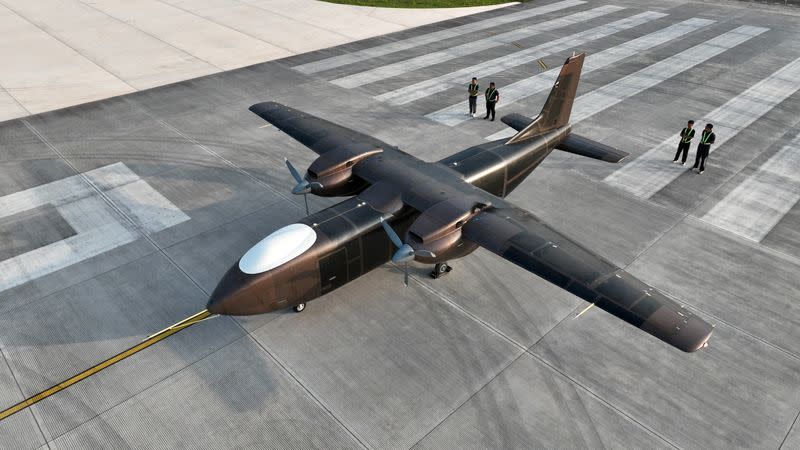China’s low-altitude economy is expanding, with pilots and engineers testing the country’s biggest cargo drone and a helicopter taxi that will soon fly on a 100km (62-mile) route to Shanghai.
The twin-engine cargo drone, developed by state-funded Sichuan Tengden Sci-tech Innovation Co, can carry a load of up to 2 metric tons.
The drone, which has a wingspan of just over 16 metres (nearly 53 feet) and a height of 4.6 metres, is slightly larger than a four-seat Cessna 172, the world’s most popular light aircraft. It took off in southwestern Sichuan province on Sunday for its inaugural flight, which that lasted about 20 minutes, state media reported.
ALSO SEE: Extreme Weather Cost China More Than $10 Billion In July Alone
Manufacturers in the world’s top drone-making nation are testing ever larger payloads while transport companies are planning air taxi services both manned and unmanned as China loosens airspace curbs and grants incentives.

Drones to carry rubbish from Everest camps
One of the first notable foreign projects to be undertaken by Chinese drones will be helping to lift a huge amount of garbage from Mt Everest in Nepal, according to a report by the Kathmandu Post on Monday.
Unmanned aerial vehicles (UAVs) made by China’s biggest drone-maker DJI (Da Jiang Innovations) will take on the task – that will save sherpas a great deal of hazardous work – by lifting waste from Camp I (at 5,943 metres) to Everest Base Camp (at 5,364m) in March to May next year, it said.
A test in April showed that DJI’s Flycart 30, a long-distance heavy-lifter drone, can carry 234kg an hour between the two camps – “a task usually accomplished by at least 14 porters in six hours,” the report said.
Nepali officials and mountaineers see the drone as a life-saving vehicle, because Sherpas must cross the hazardous Khumbu Icefall en route to the world’s highest peak, which is known to crumble when the sun is high in the sky.
Local officials plan to sign a deal with DJI soon, as nearly 60,000 people trek to Everest Base Camp every year and leave tonnes of waste at “the world’s highest garbage dump.”
Doing that could also save a lot of lives as nearly 50 people have died on Khumbu Icefall over the past 70 years, it said.
$279-billion industry foreseen
Meanwhile, China’s aviation regulator foresees drones and air taxis creating a 2-trillion-yuan ($279-billion) industry by 2030 – a four-fold expansion from 2023.
The Tengden trial run followed the maiden flight in June of a cargo drone developed by state-owned Aviation Industry Corp of China (AVIC), the leading aerospace enterprise.
The AVIC’s HH-100 has a payload capacity of 700 kg (1,543 pounds) and a flight radius of 520 km. Next year, AVIC plans to test its biggest cargo drone, the TP2000, which can carry up to 2 tons of cargo and fly four times farther than the HH-100.
China has already begun commercial deliveries by drone.
In May, cargo drone firm Phoenix Wings, part of delivery giant SF Express, started delivering fresh fruit from the island province of Hainan to southern Guangdong using Fengzhou-90 drones developed by SF, a unit of SF Holding.
Cargo drones promise shorter delivery times and lower transport costs, Chinese industry insiders say, while widening deliveries to sites lacking conventional aviation facilities, such as rooftop spaces in heavily built-up cities.
They could also ferry people on taxi services.
‘New productive force’
In April, aviation authorities issued a production certificate to unmanned aerial vehicle (UAV) maker EHang Holdings, based in the southern city of Guangzhou, for its passenger-carrying drone, China’s first such certification for an autonomous passenger drone.
In a report this year, the government identified the low-altitude economy as a new growth engine for the first time, with vertical mobility seen as a “new productive force” in areas such as passenger and cargo transport.
On Saturday, a manned commercial passenger helicopter took off for the first time from Kunshun, a city in Jiangsu province, to Shanghai Pudong Airport, state media said.
For one-way fares of up to 1,800 yuan, Shanghai NewSky Heli Co aims to cut travel time between the cities to 20 minutes from several hours. As many as 30,000 passengers a year are forecast to use the route, which opens on August 18 (next Sunday).
Shanghai aims to expand low-altitude routes to cover other cities in the Yangtze River delta.
- Reuters with additional input and editing by Jim Pollard
NOTE: Details were added to the text on August 12, 2024 about Chinese drones that will be used to carry rubbish off Mt Everest next year.
ALSO SEE:
US House Backs Ban on Drones Made by China’s DJI – TH
US Urged to Ramp Up Tariffs to Fight ‘Threat’ of Chinese Drones
US, UK Warships Knock Out ‘Largest’ Red Sea Drone Attack
US Still Backing China Firm Providing Chips for Drones, PLA Units
Biden, Xi Will Vow to Ban AI in Nuclear Weapons, Drones – SCMP
China Expands Drone Export Curbs to ‘Maintain World Peace’
Russia Buying Chinese Drones for War in Ukraine – Nikkei
China Drone Maker, Genomics Firm, Others Added to US Blacklist
























